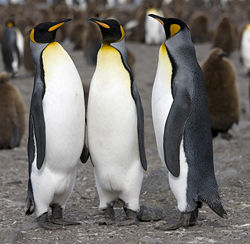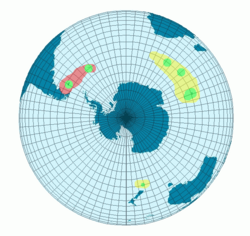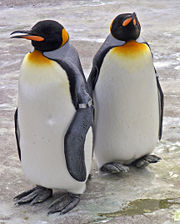King Penguin
| King Penguin | ||||||||||||||
|---|---|---|---|---|---|---|---|---|---|---|---|---|---|---|
 King Penguins in South Georgia
|
||||||||||||||
| Conservation status | ||||||||||||||
|
Least Concern (IUCN 3.1) |
||||||||||||||
| Scientific classification | ||||||||||||||
|
||||||||||||||
| Binomial name | ||||||||||||||
| Aptenodytes patagonicus Miller,JF, 1778 |
||||||||||||||
 |
The King Penguin (Aptenodytes patagonicus) is the second largest species of penguin at about 90 cm (3 ft) tall and weighing 11 to 16 kg (24 to 35 lb), second only to the Emperor Penguin. There are two subspecies - A. p. patagonicus and A. p. halli; patagonicus is found in the South Atlantic and halli elsewhere.
King penguins eat small fish, mainly lanternfish, and squid and rely less than most Southern Ocean predators on krill and other crustaceans. On foraging trips they repeatedly dive to over 100 meters (350 feet), often over 200 meters (700 feet). This is far deeper than other penguins, other than their closest relative, the larger Emperor penguin.
King Penguins breed on the subantarctic islands at the northern reaches of Antarctica, as well as Tierra del Fuego, the Falkland Islands, and other temperate islands of the region. The total population is estimated to be 2.23 million pairs and is increasing.[1]
Contents |
Taxonomy
The King Penguin was described in 1778 by English naturalist and illustrator John Frederick Miller, its generic name derived from the Ancient Greek a/α 'without' pteno-/πτηνο- 'feather' or 'wing' and dytes/δυτης 'diver'.[2] Its specific epithet patagonicus derived from Patagonia.
Together with the similarly coloured but larger Emperor Penguin (A. forsteri), it is one of two extant species in the genus Aptenodytes. Fossil evidence of a third species—Ridgen's Penguin (A. ridgeni)—has been found in fossil records from the late Pliocene, about three million years ago, in New Zealand.[3] Studies of penguin behaviour and genetics have proposed that the genus Aptenodytes is basal; in other words, that it split off from a branch which led to all other living penguin species.[4] Mitochondrial and nuclear DNA evidence suggests this split occurred around 40 million years ago.[5]
Subspecies
The ornithologist Gregory Mathews proposed the two subspecies currently recognised in 1911:[6]
- A. p. patagonicus breeds on South Georgia and Falkland Islands in the South Atlantic.[7]
Description
The King Penguin is the second largest species of penguin at about 90 cm (3 ft) tall and weighing 11 to 16 kg (24 to 35 lb), second only to the Emperor Penguin. Like all penguin species, it has a streamlined body to minimise drag while swimming, and wings that have become stiff, flat flippers.[8] There is little difference in plumage between the male and female, although the latter are slightly smaller.[7] The upperparts are steel blue-grey, darkening to black on the head, sharply delineated from the pale underparts; the belly is white colouring to orange on the upper breast with bright orange ear patches. The 12-13 cm (4¾-5 in) black bill is long and slender, and curved downwards. The lower mandible bears a striking pink or orange-coloured mandibular plate.[7]
An immature bird will have yellow- rather than orange-tinged markings, and grey tips to its black brown feathers. It moults into adult plumage at after reaching two years of age.[9]
The chick is first covered with brown-grey down, before moulting into a thick, woolly brown coat borne until around 10-12 months of age. Their mandibular plates are black until the moult into immature plumage.[7]
Adaptations to the environment
King penguins have adapted well to their extreme living conditions in the subantarctic. To keep warm, the penguins have four layers of feathering. The outer layer of feathers are oiled and waterproof, not unlike the feathering of a duck. The inner three layers are down feathers, very effective insulation. A chick is born without the oily outer layer, and therefore cannot fish until maturity.
Drinking
Like most penguins, the King Penguin is able to drink salt water because of their supraorbital gland which filters excess salt from their blood stream by way of a capillary just above the penguin's eyes. The excess salt is then expelled through the penguin's nose in a salty brine.
Distribution and habitat

King Penguins breed on the subantarctic islands between 45 and 55oS, at the northern reaches of Antarctica, as well as Tierra del Fuego, the Falkland Islands, and other temperate islands of the region. The total population is estimated to be 2.23 million pairs and is increasing.[10] The largest breeding populations are on Crozet Island, with around 455,000 pairs, 228,000 pairs on the Prince Edward Islands, 240,000 - 280,000 on the Kerguelen Islands and over 100, 000 on the South Georgia Islands. Macquarie Island has around 70,000 pairs. The non-breeding range is poorly known though presumably the subantarctic waters of the southern Indian, South Atlantic and Asian part of the Southern Ocean. Vagrant birds have been recorded from the Antarctic peninsula as well as South Africa, Australia and New Zealand.
The Nature Protection Society released King Penguins in Gjesvær in Finnmark, and Røst in Lofoten in northern Norway in August 1936. Birds were reported in the area several times in the 1940s though none have been seen since 1949.[11]
Behavior

The American physiologist Gerry Kooyman revolutionized the study of penguin foraging behaviour in 1971 when he published his results from attaching automatic dive-recording devices to Emperor Penguins,[12] and recording a dive of 235 meters (770 feet) by a King Penguin in 1982.[13] The current maximum dive recorded exceeds 322 metres (1056 feet) at South Georgia,[14] and a maximum time submerged of 9 minutes recorded at the Crozet Islands.[15] The King Penguin dives to depths of 100-300 meters (350-1000 feet), spending around 5 minutes submerged, during daylight hours, and less than 30 meters (100 feet) at night.[16][14]
The majority (around 88% in one study) of dives undertaken by King Penguins are flat-bottomed; that is, the penguin dives to a certain depth and remains there for a period of time hunting (roughly 50% of total dive time) before returning to the surface. They have been described as U-shaped or W-shaped, relating to the course of the dive. The bird dives in a V-shaped or 'spike' pattern in the remaining 12% of dives; that is the bird dives at an angle through the water column, reaches a certain depth and then returns to the surface. Other penguins dive in this latter foraging pattern in contrast.[16][17] Observations at Crozet Islands revealed most King Penguins were seen within 30 km (18 mi) of the colony.[18] Using the average swimming speed, Kooyman estimated the distance travelled to foraging areas at 28 km (17 mi).[16]
Its average swimming speed is 6.5–10 km/h (4–6 mph). On shallower dives under 60 m (200 ft), it averages 2 km/h (1.25 mph) descending and ascending, while on deeper dives over 150 m (500 ft) deep, it averages 5 km/h (3 mph) in both directions.[19][14] On land, the King Penguin alternates between walking with a wobbling gait and tobogganing—sliding over the ice on its belly, propelled by its feet and wing-like flippers. Like all penguins, it is flightless.[8]
Feeding
King penguins eat small fish, and squid and rely less than most Southern Ocean predators on krill and other crustaceans. Fish constitute 80-100% of the diet, except in winter months of July and August, when they make up only 30%.[14] Lanternfish are the main fish taken, principally the species Electrona carlsbergi and Krefftichthys anderssoni, as well as Protomyctophum tenisoni. Slender escolar (Paradiplospinus gracilis) of the Gempylidae, and Champsocephalus gunneri, is also consumed. Cephalopods consumed include those of the genus Moroteuthis, the hooked squid species Kondakovia longimana, the Sevenstar Flying Squid (Martialia hyadesii), young Gonatus antarcticus and Onychoteuthis species.[14]
Predators
The King Penguin's predators include birds and aquatic mammals; Skua species (Stercorarius spp.) take small chicks and eggs, while the Snowy Sheathbill (Chionis alba) scavenges for dead chicks and unattended eggs.[20] The Leopard Seal (Hydrurga leptonyx) takes adult birds at sea.[21]
Courtship and breeding
The King Penguin is able to breed at three years of age, although only a very small minority (5% recorded at Crozet Islands) actually do then; the average age of first breeding is around 6 years.[22] King Penguins are serially monogamous. They have only one mate each year, and stay faithful to that mate. However, fidelity between years is only about 29%.[23] The long breeding cycle may contribute to this low rate.[24]
The King Penguin has an unusually prolonged breeding cycle, taking some 14-16 months from laying to offspring fledging.[25] Although pairs will attempt to breed annually, they are generally only successful one year in two, or two years in three in a triennial pattern on South Georgia.[21] The reproductive cycle begins in September to November, as birds return to colonies for a prenuptial moult. Those that were unsuccessful in breeding the previous season will often arrive earlier. They then return to the sea for three weeks before coming ashore in November or December.[26] The female penguin lays one pyriform (pear-shaped) white egg weighing 300 g (⅔ lb).[27] It is initially soft, but hardens and darkens to a pale greenish colour. It measures around 10 x 7 cm (4 x 3 in).[27] The egg is incubated for around 55 days with both birds sharing incubation in shifts of 6-18 days each. Hatching may take up to 2-3 days to complete, and chicks are born semi-altricial and nidicolous. In other words, they have only a thin covering of down and are entirely dependent on their parents for food and warmth.[28] The young chick is brooded in what is called the guard phase, spending its time balanced on its parents' feet and sheltered by its pouch.[28] During this time, the parents alternate every 3-7 days, one incubating while the other forages. This period lasts for 30-40 days before the chicks form crèches, a group of many chicks together. A penguin can leave its chick at a crèche while it fishes as a few adult penguins stay behind to look after them. Other varieties of penguins also practice this method of communal care for offspring.
By April the chicks are almost fully grown, but lose weight by fasting over the winter months, gaining it again during spring in September. Fledging then takes place in late spring/early summer.
King Penguins form huge breeding colonies - for example the colony on South Georgia Island at Salisbury Plain holds over 25,000 birds and the one at St. Andrew's Bay over 100,000 birds. Because of the long breeding cycle, colonies are continuously occupied.
The King Penguin feeds its chicks by eating a fish, digesting it slightly and regurgitating the food into the chick's mouth.
Because of their large size, King Penguin chicks take 14-16 months before they are ready to go to sea. This is markedly different from smaller penguins, who rear their chicks through a single summer when food is plentiful. King Penguins time their mating so the chicks will develop over the harshest season for fishing. In this way, by the time the young penguins are finally mature enough to leave their parents, it is summer when food is plentiful and conditions are more favorable for the young to survive alone.
Relationship with humans

Considered a flagship species, 176 individuals were counted in captivity in North American Zoos and Aquaria in 1999.[29] The species has been bred in captivity at SeaWorld in San Diego, and is exhibited at SeaWorld in Orlando, Florida, Indianapolis Zoo,[30] Detroit Zoo, Edinburgh Zoo in Scotland, Zurich Zoo in Switzerland, and 63 Seaworld in Seoul, South Korea.
It is also the emblem of Edinburgh Zoo.
Roger Tory Peterson's ornithological nickname was "King Penguin".
Notable King Penguins
- Sir Nils Olav, mascot and Colonel in Chief of the Royal Norwegian Guard
- Misha, a central character and metaphor in two novels by Ukrainian writer Andrey Kurkov
- The King Penguin is also the species of penguin represented by the popular character Pondus, an image found on various paraphernalia in many retail stores throughout Canada. Pondus originates in Danish children's books written and photographed by Ivar Myrhøj and published by publisher Lademann in the late 1960s. These penguins appeared in the animated movie "Happy Feet".
References
- BirdLife International (2004). Aptenodytes patagonicus. 2006 IUCN Red List of Threatened Species. IUCN 2006. Retrieved on 12 May 2006. Database entry includes justification for why this species is of least concern
- ↑ Shirihai, Hadoram (2002). A Complete Guide to Antarctic Wildlife. Alula Press. ISBN 951-98947-0-5.
- ↑ Liddell, Henry George and Robert Scott (1980). A Greek-English Lexicon (Abridged Edition). United Kingdom: Oxford University Press. ISBN 0-19-910207-4.
- ↑ Williams, (The Penguins) p. 13
- ↑ Jouventin P (1982). "Visual and vocal signals in penguins, their evolution and adaptive characters". Adv. ethol. 24: 1–149.
- ↑ Baker AJ, Pereira SL, Haddrath OP, Edge KA (2006). "Multiple gene evidence for expansion of extant penguins out of Antarctica due to global cooling". Proc Biol Sci. 273 (1582): 11–17. doi:. PMID 16519228. http://www.pubmedcentral.nih.gov/articlerender.fcgi?artid=1560011. Retrieved on 2008-03-21.
- ↑ Mathews, GM (1911). The Birds of Australia: Vol. 1. London: Witherby.
- ↑ 7.0 7.1 7.2 7.3 7.4 Williams (The Penguins) p. 143
- ↑ 8.0 8.1 Williams (The Penguins) p. 3
- ↑ Stonehouse, B (1960). "The King Penguin Aptenodytes patagonicus of South Georgia I. Breeding behaviour and development". Scientific Report of the Falkland Islands Dependencies Survey 23: 1–81.
- ↑ Shirihai, Hadoram (2002). A Complete Guide to Antarctic Wildlife. Alula Press. ISBN 951-98947-0-5.
- ↑ Long, John L. (1981). Introduced Birds of the World: The worldwide history, distribution and influence of birds introduced to new environments. Terrey Hills, Sydney: Reed. pp. p. 30. ISBN 0-589-50260-3.
- ↑ Kooyman GL, Drabek CM, Elsner R, Campbell WB (1971). "Diving behaviour of the Emperor Penguin Aptenodytes forsteri". Auk 88: 775–95.
- ↑ Kooyman GL, Davis RW, Croxall JP, Costa DP (1982). "Diving depths and energy requirements of the King Penguins". Science 217: 726–27. doi:. PMID 7100916.
- ↑ 14.0 14.1 14.2 14.3 14.4 Williams (The Penguins) p. 147
- ↑ Williams (The Penguins) p. 89
- ↑ 16.0 16.1 16.2 Kooyman GL, Cherel Y, Le Maho Y, Croxall JP, Thorson PH, Ridoux V (1992). "Diving behaviour and energetics during foraging cycles in King Penguins". Ecological Monographs 62: 143–63. doi:.
- ↑ Williams (The Penguins) p. 87-88
- ↑ (French)Ridoux V, Jouventin P, Stahl J-C, Weimerskirch H (1988). "Ecologie alimentaire comparée des manchots nicheurs aux Iles Crozet". Revues Ecologie 43: 345–55.
- ↑ Adams, NJ (1987). "Foraging ranges of King Pengions Aptenodytes patagonicus during summer at Marion Island". Journal of Zoology 212: 475–82.
- ↑ Williams (The Penguins) p. 40
- ↑ 21.0 21.1 Stonehouse, B (1960). "The King Penguin Aptenodytes patagonicus of South Georgia I. Breeding behaviour and development". Falkland Islands Dependencies Survey Scientific Report 23: 1–81.
- ↑ Williams (The Penguins) p. 151
- ↑ Williams (The Penguins) p. 54
- ↑ Williams (The Penguins) p. 152
- ↑ Williams (The Penguins) p. 148
- ↑ Williams (The Penguins) p. 149
- ↑ 27.0 27.1 Williams (The Penguins) p. 150
- ↑ 28.0 28.1 Williams (The Penguins) p. 28
- ↑ Diebold EN, Branch S, Henry L (1999). "Management of penguin populations in North American zoos and aquariums" (PDF). Marine Ornithology 27: 171–76. http://www.marineornithology.org/PDF/27/27_21.pdf. Retrieved on 2008-03-31.
- ↑ "Penguins-an overview". Indianapolis Zoo website. Indianapolis Zoo (2008). Retrieved on 2008-04-01.
Cited text
- Williams, Tony D. (1995). The Penguins. Oxford, England: Oxford University Press.
External links
- 70South - more info on the King penguin
- www.pinguins.info: A lot of information about all penguin species
- King penguins from the International Penguin Conservation Web Site
- http://animaldiversity.ummz.umich.edu/site/accounts/information/Aptenodytes_patagonicus.html King Penguins from the Animal Diversity Web]
- Penguins in the Falklands
- King Penguin videos on the Internet Bird Collection
- Penguin World: King penguin
- See also the famous art-project Penguins - Traveling the World - Photographs by Willy Puchner
- Roscoe, R. "King Penguin". Photo Volcaniaca. Retrieved on 13 April 2008.